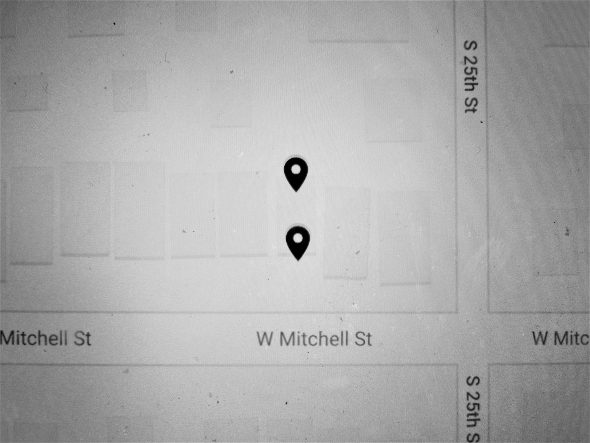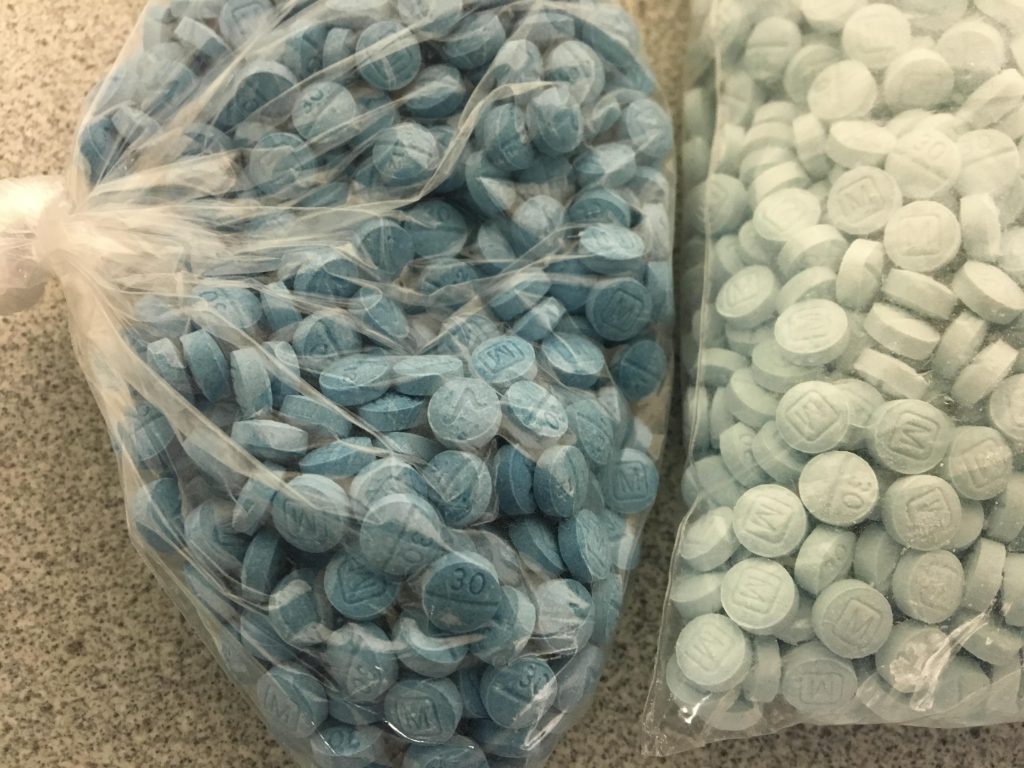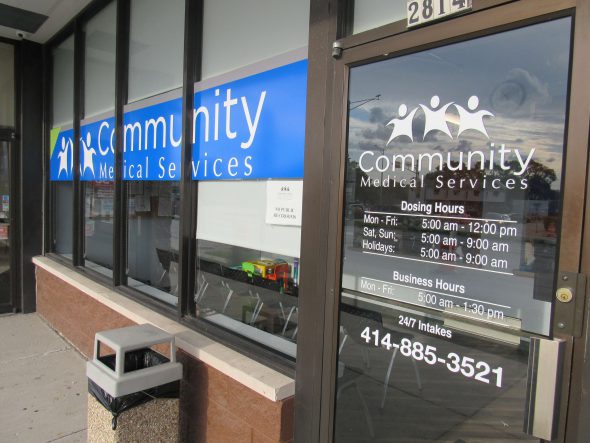Maps Tell Story of City’s Overdose Crisis
2020 on pace to shatter record for drug overdoses. High rate of deaths on South Side.
In many ways, the trials of 2020 have applied unprecedented pressures to the very fabric of society. For people struggling with addiction, the economic gloom created by COVID-19 and protesters’ roars from the streets only compound their daily struggles. That fact has not gone unnoticed by people on the ground in Milwaukee who are dedicating themselves to saving lives and lowering the number of those dying from an overdose.
As of July 8th, 226 people have died in Milwaukee County from drug-related deaths this year. For treatment providers and advocates, it’s a never-ending race against the clock to prevent more fatalities. Deanne Lawson, executive director of the Inner Beauty Center (IBC) on Milwaukee’s South Side, says her organization’s street outreach operations have been especially busy.
The Inner Beauty Center helps women who have been sexually exploited, and are now struggling with homelessness and drug addiction. “We are definitely seeing a fair amount of opiate addiction,” says Lawson. “I would say that if it’s pills, it quickly goes to heroin use. Because heroin is so much more available, and a lot cheaper than buying pills.”
To get a complete bird’s eye view of where fatal drug overdoses occurred in Milwaukee, Wisconsin Examiner created two maps, one for 2019 and another for 2018. The points on the map are color-coded according to the cause of death of each individual. A key to what the colors mean can also be found below and most of the points will show specific information if you click on them.
These maps were created using data from the Milwaukee County Medical Examiner’s Office and include all drug-related deaths in the county. Hospital deaths were not included as the goal of the maps is to examine deaths where help did not arrive in time.
Key: Black– mainly fentanyl | Purple – fentanyl with another drug like MDMA or oxycodonexy, but no heroin/cocaine | Brown – a combination of multiple drugs, at least one being fentanyl | Violet– heroin, cocaine, fentanyl |Yellow – cocaine and heroin, no fentanyl | Blue – mainly heroin | Red – heroin and fentanyl mainly | Green– mainly cocaine | Red Purple – cocaine and fentanyl mainly |Orange – meth is listed, no cocaine, heroin or fentanyl | Dark Blue – meth is listed with cocaine, heroin or fentanyl | Gray– other
The 2019 overdose map
418 deaths
The 2018 overdose map
384 deaths
At first glance the deaths may appear widespread, and they are. Nevertheless, patterns can be found in the points, from portions of the city with large death clusters, to smaller pockets where a group of residents perished under similar circumstances. Milwaukee’s South Side, where Lawson and her team operate, sees dense clusters of overdose deaths year after year. In 2019, 418 people died of drug-related deaths in Milwaukee County, a record-setting figure. The year before in 2018, 384 people died, with 2017, at 401 deaths, being the last time Milwaukee’s record was broken.
So far 2020 isn’t much better. On April 1, the medical examiner’s office tweeted: “Drug overdose deaths continue to surge. If current trends continue, 640 people will die in Milwaukee County this year from a drug overdose.” And yes, that would mean yet another record-shattering year for lives lost to overdose in Milwaukee.
So far this year heroin has been listed as causing deaths 40 times, cocaine 111 times, fentanyl 160 times and meth 14 times. In 2019, heroin was listed 131 times, cocaine 177 times, fentanyl 242 times, and methamphetamine 16 times. Some 273 people in 2019 died with several compounds in their systems, and were listed as an “acute mixed drug intoxication.”
After losing several loved ones to overdose, Mercado helped create the Milwaukee Heroin Diaries, a community group with a Facebook page that aims to raise awareness of the disease of addiction and promote the humanity of users. “I’m being asked more to go to residences to train family members of loved ones who are fighting the disease so they are prepared,” explains Mercado, who also helps run Team HAVOK, a community organization. “It’s sad, but good that the families are at least reaching out to be trained in the administration of Naloxone.”
Naloxone, better known as Narcan, is a medication used to revive someone who is suffering an overdose. It has been widely touted as crucial in the fight to save lives for first responders, average citizens, those struggling with drug addiction and their families. Narcan specifically reverses overdoses from opioids and similar drugs like heroin, which is an opiate.
Saving individuals lives provides them with more opportunities to seek treatment to overcome their addiction. The demand for treatment centers is growing as more people are affected by drug addiction and overdose. Community Medical Services (CMS), a medication-assisted treatment center in the Milwaukee suburb of West Allis, is seeing an uptick of new patients as 2020 drags on.
“We had serious intakes,” Amy Molinski, who works in peer support at the West Allis CMS clinic tells the Wisconsin Examiner, speaking of the early portions of 2020. “But there was no consistency to it. So one day we’d get 12, the next day we’d get two or three. And there was just like an ebb and flow. Now, it’s just steady, consistent. I would say we’re getting seven to 12 a day, every day … just insanity.”
Some, about four or five of that 12 daily figure, may be people returning to the program, whereas the rest are new faces, Molinski explains. “It’s really intense at the clinic right now, as far as new intakes go.”
Lawson has also seen an uptick of trafficked and drug-addicted women on the street. “So we started out talking to maybe 12 or 15 women,” she tells Wisconsin Examiner. “Now we’re making connections with 20 women or more every day that we go out.”
Patterns in the data
As Molinski works at the ground level with new patients and outreach, her colleague Amanda Rodriguez, community programs and integrations manager at the West Allis CMS clinic, monitors the regular overdose reports CMS receives from the medical examiner’s office. Though the total number of overdose deaths in the county appears daunting, the daily reports Rodriguez sees show some encouraging signs.
“What we’re finding from our community partners is because people are now using with other people,” she explains, “we’re seeing the amount of Narcan being used on people who are overdosing … we’re seeing that go through the roof. And we’re not seeing as many people dying, and it’s because people are using together now. So there’s somebody there to call 911.”
Molinski notes those sorts of trends generally depend on what stage in their addiction a person happens to be. Through outreach, however, advocates are able to inform active users of key precautions for harm reduction. Molinski lists them off: “Use with a friend, have Narcan on you, use fentanyl testing trips.”
“So, I would say there’s less overdose deaths as part of the promotion of harm reduction, and the availability of harm reduction tools,” she says. When exactly the person chooses to use the drug once they purchase it also varies depending on the user.
“Since so many people are coming from the suburbs and driving into the city to pick up drugs the majority of those people are using immediately in their car, as soon as they pull around the corner,” explains Molinski. “It brings a different level of urgency when it’s someone who lives in the neighborhoods, and is picking up within their own neighborhoods, not by vehicle.”
John Koch, Community Engagement Director for CMS, agrees that it depends on the person and situation. Koch struggled with addiction as a young adult in Chicago, and saw first-hand how popular areas to buy drugs operated. “They had blocks,” explains Koch, laying out a system not unlike what probably happens in parts of Milwaukee. “The dealers and the people in that area didn’t want you to just use right there because if you died, or overdosed or something, then that brought heat [police]. So they were just like, ‘Buy and get out.’”
Koch’s days on the street ended nearly a decade ago. More recently, Lawson has witnessed a new generation of dealers conduct business in broad daylight, right in front of her as IBC conducts street outreach. “We’ve pulled over to talk to some ladies,” Lawson tells Wisconsin Examiner, “and a car has pulled over across from us. And we saw probably eight drug deals go down right in front of us. They don’t even care.”
Reacting incredulously to this brazenness Lawson declares, “They could care less. And our vehicle is clearly marked that we’re an organization out there. It’s not like we’re just somebody pulled over … and they’re doing multiple drug deals right in front of us.” She suspects that this attitude has influenced Milwaukee’s trends in addiction and overdose.
Going through the Medical Examiner’s drug-related death lists, one drug has begun popping up more. Gabapentin, sold under numerous brand names including Neurontin, is a medication used to treat neuropathic pain, seizures, hot flashes, and restless legs syndrome. Doctors have also prescribed it off-label for a variety of conditions including bipolar disorder and as a drug to treat opioid withdrawal.
“We have seen this compound grow tremendously in frequency over the last couple of years,” Sara Schreiber, forensic technical director for the medical examiner’s office, tells Wisconsin Examiner.
The drug is frequently prescribed as an alternative to opioid therapy—especially for individuals who are addicted to opioids,” explains Schreiber. Essentially, it is a replacement pain killer for chronic pain patients.
Studies have found that 40-65% of people prescribed gabapentin misuse the drug, and about 15-22% of people who abuse opioids also abuse gabapentin. More research is being conducted into the drug’s abuse potential, but it has been shown to cause euphoric effects which could lead to abuse.
Gabapentin was detected among Milwaukee drug-related deaths 13 times in 2018, and 39 times in 2019. So far, half way into 2020, the drug has been detected 27 times. “We’re finding it in combinations of things that seem to be very abusive,” says Schreiber, “the concentrations here appear to be abusive. They’re beyond therapeutic.”
Trapped in a ruthlessly lethal cycle
Looking at the Wisconsin Examiner’s overdose death maps, you might notice individual buildings where multiple people have died. Sometimes these are apartments, or other high-density areas where more than one fatality isn’t necessarily unusual. Two overdoses in 2019, however, caught the map maker’s eye. At an ordinary house off of 25th and Mitchell Street two fentanyl deaths were reported, four months apart.

The two points on the 2019 map, showing two fentanyl deaths at the same house on Milwaukee’s southside. Photo by Isiah Holmes/Wisconsin Examiner.
At this point, fatalities from overdoses are outpacing fatalities from car accidents in America. Still, those who have never struggled with addiction may wonder why the death of a friend or family member doesn’t spur people to quit.
For active users, Molinski explains, “losing someone does not encourage someone to get better. Typically, by the time someone is surrounded by people who are dying of overdoses, oftentimes those people hate themselves so much that it’s not that they’re trying to kill themselves. They’re just not trying not to die. So, they don’t necessarily want to die, but they’re very tired from living the way they are. So they’re not putting a whole lot of effort into staying alive either. If it happens, it happens. And that’s the mentality of a lot of people who are using.”
Many new intake patients at CMS deny being suicidal, yet don’t want to continue living in their current condition.
People who abuse drugs like heroin, methamphetamine, cocaine and others can be exposed to a whole host of health complications. “These drug dealers really don’t care,” says Lawson. “I can probably name [to] you at least half a dozen women who have gotten horrible infections from tainted heroin. They’ve ended up in the hospital, they’ve almost lost limbs. It has something in it, or it hasn’t been handled properly or something, I don’t know.”
Heroin can be a mystery box of chemicals and compounds, and issues including abscess are common. Over the last year, however, Lawson’s team has encountered more women who have had close calls with this particular recipe for the drug.
“The women end up really sick,” she told Wisconsin Examiner, “and we have had a few that have overdosed because of that. We have had multiple women who have ended up in the hospital and when they come out they have serious cardiac issues, because of the infection. For some reason that opiate, especially heroin, tends to attack the heart. And they’ll end up with leaking valves, they’ll have open heart surgery. They’ll end up with a part of their heart just not functioning because of the infection that they’ve had.”
Convincing the women to seek medical help can be challenging for IBC. Whether it’s because they’re afraid they can’t afford it, or out of shame. Lawson has noticed some hospitals can be reluctant to provide active users with pain medications. Weighing their options, Lawson said many of the women take their chances with tending to sores and infections at home. “We’ve had a number of women, they’ve been on their death bed. The ER said, ‘another hour, another half a day, and you [the patient] would’ve been dead because of the severity of the infection.’”
Molinski also points out that many with active addiction have a superman-like mentality that they’ll never die from an overdose. The assumption grows that those who died were reckless, or made preventable mistakes.
“They really think that they’re beating the system,” she explains. “That’s the part about opiate addiction. It is cunning, baffling and powerful. And that cunning part, where that part of your brain makes you believe that everyone else that’s dying from it is doing it wrong — and you know how to do it right — that’s what the addict thinks. A using addict thinks they know better than the people who have died from it, every time.”
Battling NIMBY to open the doors to recovery
A new Community Medical Services clinic is in the works at the moment, set to open in the South Side of Milwaukee. The predominantly Hispanic neighborhoods, areas near where IBC reach out to addicted and trafficked women, are hot spots for fatal overdoses every year.
Further south you’ll find the City of South Milwaukee, a separate municipality with its own mayor. Elected officials and residents from both areas have expressed great interest in CMS opening a clinic nearby. That, however, wasn’t the case when the treatment specialists first attempted to open a clinic in Milwaukee’s North Side.
Koch was on the front line for those early efforts, sending out over 17,000 fliers in a mile and a half radius from the area and organizing community listening sessions. Immediately, Koch said that he encountered many residents with fearful “Not In My Back Yard” (NIMBY) attitudes.
“We went to the first engagement session and there were not that many people there,” says Koch. Although some were supportive, others were irate at the idea of a treatment center coming to their neighborhood. Koch recalls comments like, “You’re going to bring drug addicts to my neighborhood, and you’re going to bring drug dealers to my neighborhood.”
What they didn’t understand was that CMS hadn’t just randomly selected their area to open up. “Our reports had shown that this was an area that needed help,” Koch says. “It didn’t have treatment around it. We don’t pick a place to move right next to another opioid treatment program because we’re hoping that program is addressing the needs in that community. And we also looked at overdoses, and there were some in this area of Capital Drive.”
Koch didn’t give up. He sent out more fliers to hold a second community engagement meeting. He was then inundated with communiques from locals, again a mixed bag of support and fear-driven anger. “There were some people that were community members saying, ‘If you open in our area, we’ll stand outside. We’ll make sure that you can’t hire anybody, we’ll mess with your facility. Even one person went as far as [saying], ‘Go ahead and open in our area and I can guarantee that I’ll take care of you.’ Just these kinds of threatening things.”
Before one of the meetings held at a local library, Koch was surprised to see a police car pull up in front of the building. Library staff told him that someone had made threats, and the police were there as security. Candidates for alder representing the region were also split between supporting CMS and fanning the flames of fear among their supporters. “They just attacked us the whole time,” recalls Koch, who endured a verbal onslaught from residents at the meeting, alongside his colleagues.
Even sympathetic candidates found it impossible to ignore community demands to not open the treatment center. Due to this, and complications with Milwaukee’s Board of Zoning Appeals (BOZA), CMS decided not to open. Instead, they went to nearby West Allis, which was very welcoming to CMS. The center became Wisconsin’s first 24 hour opioid treatment program, and has been helping patients ever since. “We opened in West Allis in April of last year,” Koch explains with pride. “It’s now our third largest clinic in the United States. It’s done over 1,000 intakes and grown exponentially.”
Expanding into the South Side of Milwaukee is a big win, but Koch feels NIMBY is still prevalent. “That’s what it takes, it takes a community,” said Koch. “It’s not a single person, we have to address this as a community.” Lawson sees the same thing play out in her own work. She spoke with a small business owner not too long ago while conducting street outreach. He’d noticed an uptick in the number of addicted and trafficked women, and didn’t know what to do since their presence was affecting his business.
Lawson explains that it’s actually the demand from their male customers that increases the women’s presence. “We’re seeing new women. Every time we go out we see one or two, maybe three new faces out there every week,” Lawson lays. “That’s just been in the last maybe two months that there’s been that increase. It’s normal to see maybe one new person a week. But we’re seeing at least three new faces every week.”
COVID-19 has not dampened the demand for drugs, or other vicious cycles fueled by the lifestyle. In these trying times, the specter of addiction looms over those praying for another day more heavily than it ever has. “If we think that we are going to be able to say, ‘Yeah, people need help, just not in my neighborhood. Not in my backyard,’” warns Koch, “[then] we will never, ever get close to stopping this preventable disease from taking lives.”
Reprinted with permission of Wisconsin Examiner.
More about the Opioid Crisis
- Menominee Tribe Has 70% Decline in Overdose Deaths, Hospitalizations - Joe Schulz - Nov 27th, 2024
- Serenity Inns: A Proven Lifesaving Facility Denied Critical State Funding - Serenity Inns - Nov 19th, 2024
- Milwaukee County Outreach Team Going Door-to-Door Handing Out Narcan in High Overdose Areas - Evan Casey - Nov 14th, 2024
- DHS Launches New System to Help Communities Track and Respond to Overdose - Wisconsin Department of Health Services - Nov 14th, 2024
- Attorney General Kaul and Bipartisan Coalition of 30 States Announce Settlement with Kroger Over Opioid Crisis - Wisconsin Department of Justice - Nov 6th, 2024
- Baldwin Calls on Biden Administration to Investigate China’s Role in Fueling the Fentanyl Crisis - U.S. Sen. Tammy Baldwin - Oct 23rd, 2024
- Baldwin Brings Home $750,000 for Northeastern Wisconsin to Combat Fentanyl and Opioid Epidemic - U.S. Sen. Tammy Baldwin - Sep 27th, 2024
- AG Kaul Meets with EMS Leave Behind Program Recipients - Wisconsin Department of Justice - Sep 17th, 2024
- MKE County: Crowley Signs Opioid Program Funding - Graham Kilmer - Sep 10th, 2024
- Serenity Inns Opens New Addiction Treatment Center in Milwaukee - Serenity Inns - Aug 14th, 2024
Read more about Opioid Crisis here























